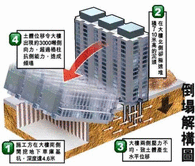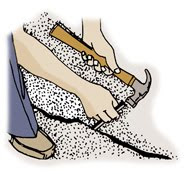On runways and highways, the concrete blocks start "whipping" when the traffic is moving over them. This has become a bigger and bigger problem. There are two ways to remedy this. One older method is to inject bitumen under the blocks. This could be a problem in hot climates where the bitumen softens up.
The method we have developed utilizes a concrete we call LWCB (light weight concrete bubbles), developed and patented by Senad LWC. You can even stabilize places where you have high ground water. This is a chemical process without any environmental harm. The more and more heavy aircraft, the more problems are created on runways and taxiways - and even highways, especially where there are bridges.

The first thing to do is remove all old concrete and asphalt (if you have an overlay) from the area you need to repair. Remove the old joint seal and remove the loose concrete pieces. Clean the joint with a compressed air lance, and then fill it with MAC 140 joint seal. (The reason for this is you don't want to have the LWCB coming up between the blocks.)
Drill two to four holes approximately 75-100 cm from the edges and corners and press down the injection nozzle as deeply as you can to get a better foundation. Have a leveling bar so you can see how much you should lift the block (be aware that the last few millimeters will go very quickly). Put a wooden plug in the hole to avoid the concrete pressing out during the first 30-60 minutes. After that, you can drive on the block.
Or we can also use a special truck with a special rotator for mixing the concrete and pumping the liquid through four hoses - one in each corner - to lift the blocks. In that case, we can attach a computer for measurement and have a better control over the lifting process, and at the end, we can generate a graph of the operation. Of course, this is only suitable when you have a bigger area to be stabilized. In both cases, you have to have certain reference points behind the block which needs to be stabilized.
LWCB has the capability to go far beyond the injected area. The best thing is to have a measurement laser (you don't want to have a ski jump!). Our LWCB is not compatible with what you call LWC that is specially formulated to meet the specifications for both runways and highways and can take a very high load - both on aprons and touch-down areas. This LWCB has a density between 800-1200 kg/m - depending on how many chemicals you are using and the softness of the subbase. For more information, please contact us.
This method may be used in both cold and hot climates and saves considerable money - instead of breaking the block and making a new block, which takes several days,
The next step is to glue the MACPAVE membrane over the joints to avoid a crack in the new overlay. When the movement is up to 3-4 cm, you might try using our Type 2 repair method (see graphic below). This is also usable on bridge joints.

With this method, you need a milling machine with a maximum drum width of 35 cm and depth of 10-12 cm after milling. Clean the trench carefully and blow away the debris with a pressurized air lance. Remove the old joint seal and refill with our JOINT SEAL MAC140 and apply our special 30 cm wide membrane.
The next step is to fill up to the level with asphalt concrete and compact it. Then glue on a 1-meter (42 inch) width membrane before you make the final paving overlays. Now the crack can take a movement of 3-4 cm width in both directions. (Note: it's very important to remove loose concrete fragments from the edges - you need to have free movement between the blocks.)
 |  |
You are getting water down into the subbase through the cracks and you have a wet area. Then when the wet subbase freezes, it will lift and make a little bump. The reason this increases every year is that at the same time, you have leakage down through the runway, you also have capillary leakage from the side of the runway/highway into the subbase. And in a rainy autumn, you can guess what you have to expect during the winter period.

Question: What do you do where a concrete runway meets a flexible pavement?
This is another frequent question and a great problem according to the emails we get. When a concrete runway meets a flexible pavement, it always creates big problems. Of course, they are two different materials and have two different movements. And when you make a new overlay, you are liable to get a big crack over the area after only one or two years - both longitudinally and as a difference in height. This is a place where you can use our Type 2 repair method (see graphic above). If you have a stable subbase, you can use only a 102 cm width of MACPAVE membrane without milling.
The Finnish airport Vaanta Helsinki had this problem, and six years ago they designed an overlay with MACPAVE membranes. During a check-up this summer (2002), it was determined that no cracks have returned.
We have very high confidence in our product, and we also have a great amount of experience solving different types of problems around the globe. We can come back after several years and look the engineers in the eye and say, "This is the best product you can buy today to solve your paving problems."
We hope you find these answers helpful and eagerly await further questions regarding your specific problems - whether they be about airports, highways, roads, city streets, bridge decks or parking decks. Please don't hesitate to contact us. We are always willing to address your problems regarding asphalt.















 Dollar Amerika tukar, currency converter
Dollar Amerika tukar, currency converter
No comments:
Post a Comment